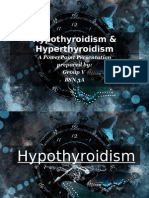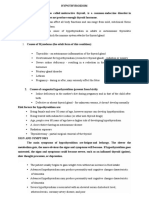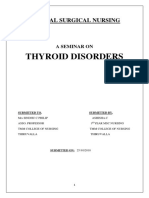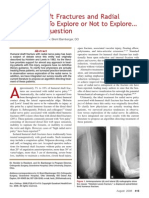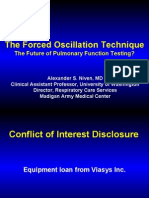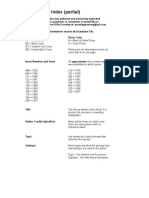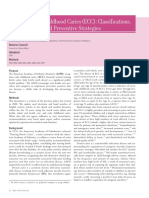Pedia
Pedia
Uploaded by
Rex Flores EstuboCopyright:
Available Formats
Pedia
Pedia
Uploaded by
Rex Flores EstuboOriginal Title
Copyright
Available Formats
Share this document
Did you find this document useful?
Is this content inappropriate?
Copyright:
Available Formats
Pedia
Pedia
Uploaded by
Rex Flores EstuboCopyright:
Available Formats
CARE OF PEDIATRIC CLIENTS WITH ENDOCRINE DISORDER AND METABOLIC DISORDERS Endocrine System - controls or regulates metabolic processes
governing energy production, growth, fluid and electrolyte balance, response to stress and sexual reproduction. Hormones - is a complex chemical substance produced and secreted into body fluids by a cell or group of cells that exerts a physiologic controlling effect on other cells. are released by endocrine glands into the bloodstream, where they are carried to responsive tissues.
Pituitary gland Ductless gland. Main gland located at base of brain of Sella Turcica. Anterior pituitary gland adenohypophysis. Posterior pituitary gland neurohypophysis. Master gland of body. Master clock of body.
ADH (anti-diuretic hormone)/ vasopressin - prevents urination conserves H2O. is the major control of osmolality (concentration) and body water volume. increases water reabsorption in the collecting ducts of the kidneys.
DIABETES INSIPIDUS - (Dalas Ihi) because of hyposecretion or decrease of ADH. Cause: Idiopathic. Predisposing factors: Pituitary surgery, Trauma/ head injury, Tumor, Inflammation.
* alcohol inhibits release of ADH S/Sx Polyuria Sx of dehydration 1st sx of dehydration in children tachycardia Excessive thirst (adult) Agitation Poor skin turgor Dry mucus membrane Weakness & fatigue Hypotension if left untreated Hypovolemic shock Anuria late sign hypovolemic shock Diagnostic Test Decrease urine specific gravity (less concentrated). Normal value = 1.015 1.035. Serum Na = increase! (Normal value =135 -145 meq/L). Hypernatremia (increase water loss).
Nursing Mgt Force fluids (2,000 3,000ml/day) Administer IV fluid replacement as ordered Monitor VS, I & O Administer meds as ordered a.) Pitressin (vasopressin) IM
Prevent complications Most feared complication Hypovolemic shock
SYNDROME OF INAPPROPRIATE ANTI- DIURETIC HORMONE (SIADH) - increase ADH Cause: Idiopathic. Predisposing Factor: Head injury, Related to Bronchogenic cancer or lung cancer. Early Sign of Lung Ca: Cough 1. non productive 2. productive Hyperplasia of Pituitary gland (Increase size of organ) S/Sx Fluid retention Increase BP HPN Edema Wt gain Danger of H2O intoxication Complications cerebral edema increase ICP seizure
Diagnostic Test Urine specific gravity increase (more concentrated urine) Hyponatremia Decreased Na (more H2O is retained)
Nursing Mgt Restrict fluid Administer meds as ordered e.g. Diuretics: Loop (e.g. Furosemide) and Osmotic (e.g. Mannitol) Monitor strictly: V/S, I&O, neuro-check increase ICP Weigh daily Assess for presence edema Provide meticulous skin care Prevent complications increase ICP & seizures activity
Anterior Pituitary Gland Hormones Growth hormone (GH) or Somatotropic hormone (STH) Functions Elongation of long bones Decrease GH during childhood dwarfism Increase GH during childhood gigantism Increase GH during adulthood acromegaly Puberty: 9 y/o 21 y/o Epiphyseal plate closes at 21 y/o
Hypopituitary Dwarfism - hypopituitary gland dysfunction, can lead to a decrease in production of human growth hormone (somatotrpin). Cause: Idiopathic Predisposing Factors Nonmalignant cystic tumors of embryonic origin, which causes pressure on the pituitary gland, or increased intracranial pressure from another cause; a history of loss of vision, headache, increased head circumference, nausea, and vomiting is suggestive of pituitary tumor. When this hormone is deficient, it causes a child to remain short in stature. Without treatment, the child will not reach a height over 3 to 4 feet. Synthetic growth hormone needed to treat hypopituitary dwarfism is readily available. Accompanying treatment depends on accompanying pituitary dysfunctions and may include supplements of gonadotropin or other hormones.
Assessment Lower than standard height and weight on growth charts after 2 to 3 years of life Recessed mandible Small nose High-pitched voice Delayed onset of pubic, facial, and axillary hair and genital growth Decreased level of circulating growth hormone
Nursing Interventions Rule out the presence of a pituitary tumor, such as is suggested with sudden halt in growth. Obtain blood studies to rule out hypothyroidism, hypoadrenalism, and hypoaldosteronism because these conditions can influence growth. Obtain information regarding bone age from x-ray films. Prepare the family for necessary scans to detect possible enlargement of the sella turcica, which would suggest pituitary tumor. Educate the family on the need to complete the child with hypopituitary dwarfism by administration of intramuscular human growth hormone injections 2 to 3 times per week (25 to 50 mcg/kg).
Pituitary Gigantism - is generally caused by an overproduction of growth hormone, usually a result of a tumor of the anterior pituitary. Excessive growth can be caused by an overproduction of growth hormone before the epiphysial lines of the long bones close. Weight is also excessive but proportional to the height. excessive growth becomes evident at puberty. Acromegaly may accompany the excessive growth in stature, becoming more pronounced after the epiphysial lines of the long bones close and linear growth is no longer possible. Untreated the child can reach a height of 8 feet. Surgical removal of the tumor or cryosurgery is required if the increased growth hormone is from an adenoma. Irradiation or radioactive implants to reduce the growth hormones required if no tumor is found.
Assessment Increased skull circumference Fontanelles closing late or not at all Enlarged thick tongue
Nursing Interventions Explain to parents what the pituitary gland does and how a tumor is affecting the childs growth. Discuss the treatment options available to the child and prepare the family and child for surgical intervention if necessary. The child may require thyroid extract, cortisol, and gonadotropin hormones if the treatment eradicates pituitary functioning. Inform the parents and child that the increased height and weight cannot be reversed but can be controlled now that a diagnosis has been made and treatment initiated.
THYROID GLAND - is located at the base of the throat, just inferior to the thyroid cartilage; it consists of two lobes joined by a central mass called isthmus; the thyroid gland is composed of hollow structures called thyroid follicles;
Normal physical finding on TG thyroid gland is never tender With nodular consistency Normal TG is never palpable unless with goiter
TG hormones T3 Triiodothyronine T4 Tetraiodothyronine/ Tyroxine
molecules of iodine
4 molecules of iodine
Metabolic hormone Increase metabolism in the brain increase cerebration, increase v/s Thyrocalcitonin lowers the levels of calcium and phosphate in the blood. function antagonizes effects of parathormone! Parathormone - (controls distribution of calcium and phosphate in the body) Hypo T3 T4 - lethargy & memory impairment All v/s down, constipation Hyper T3 T4 - agitation, restlessness, and hallucination Increase VS, increase motility of GIT HYPOTHYROIDISM Predisposing factors Iatrogenic causes caused by surgery Atrophy of TG due to: Irradiation Trauma Tumor, inflammation Iodine deficiency Autoimmune Hashimotos disease chronic autoimmune disease of thyroid resulting from antibodies to thyroglobulin.
S & Sx Everything is LOW, SLOW, and DRY LOW & SLOW: Slowed physical and mental reactions Lethargy Low body temperature Bradycardia Slow metabolism DRY Dry hair and skin Constipation (dry stool) Everything decreased except weight and menstruation (mennorhagia) which are increased.
Diagnostic Test Nursing Mgt 1. Monitor strictly V/S. I&O to determine presence of myxedema coma. Myxedema Coma - Severe form of hypothyroidism. All vital signs are profoundly depressed. It is potentially fatal. (Hypotension, hypoventilation, bradycardia, bradypnea, hyponatremia, hypoglycemia, hypothermia). Might lead to progressive stupor & coma. Important Nursing Mgt: (Myxedema Coma) Assist mechanical ventilation priority. Administer thyroid hormone replacement!. Administer IVF replacement force fluids. Monitor VS, I&O. Provide dietary intake low in calories due to wt gain. Skin care due to dry skin. Comfortable & warm environment due to cold intolerance. Administer IVF replacements. Force fluids. Administer meds take AM SE insomnia. Monitor HR. Thyroid hormones Levothyroxine (Synthroid), Liothyronine (Cytomel) Thyroid extracts Health teaching & discharge plan Avoidance precipitating factors leading to myxedema coma: 1. Exposure to cold environment. 2. Stress. 3. Infection. 4. Use of sedative, narcotics, anesthetics (not allowed CNS depressants (V/S already down) Hormonal replacement therapy (Lifetime) Importance of follow up care Serum T3 T4: decrease Serum cholesterol increase can lead to MI radioactive iodine uptake (RAIU) decrease
HYPERTHYROIDISM
Complications Hypovolemic shock, Myxedema Coma.
Hypermetabolic condition is characterized by excessive amounts of thyroid hormone in the blood; More common in women than men; Most common cause is Graves disease; - toxic goiter characterized by diffuse hyperplasia of the thyroid gland, a form of hyperthyroidism. Three important concepts 1. Increased BMR 2. Hypocalcemia 3. Increased heat production
S & Sx Everything is HIGH, FAST, and WET High and Fast Hypertension Tachycardia High body temperature WET Diaphoresis (wet skin) Diarrhea (wet stool) Eye manifestations Exopthalmos, lid lag (Von Graefes sign), bright-eyed stare, bulging of the eyes, Infrequent blinking. Nervousness and irritability Feeling to move about. Tachycardia with palpitations (90 160/min) Heat intolerance with profuse sweating and flushed skin. Fine hand tremors Increase appetite Weight loss Atrial fibrillation Jeffreys sign forehead remains smooth when one looks up. Dalrimples sign (Thyroid stare)
Diagnostic Test
Serum T3 & T4 increased Radioactive iodine uptake increased Thyroid scan reveals enlarged TG Thyroid Storm (most feared complication of hyperthyroidism): Characterized by: Severe hyperthyroidism Hyperpyrexia (high-grade fever) Diarrhea Tachycardia
Arrhythmias Extreme irritation Delirium Shock Coma Death if inadequately treated commonly precipitated by: Stress (surgery or infection) Inadequate preparation for surgery in patients with known hyperthyroidism.
Diagnostics Tests Elevated T3 and T4 Decreased TSH Elevated T3 resin uptake. Elevated radioactive iodine scan Management of Thyroid storm Drugs that inhibit thyroid hormone formation: Thionamides Propylthiouracil (PTU) Methimazole (Tapazole) - causes agranulocytosis (fever, sore throat, and skin rashes) Drugs to control peripheral manifestations: Propranolol decrease sympathetic activity and decreases heart rate Glucocorticoids Radioactive iodine therapy to destroy the gland; Surgery thyroidectomy
Nursing Interventions Nursing Mgt Monitor VS & I & O determine presence of thyroid storm Administer meds: (Antithyroid agents) Prophylthiuracil (PTU) Methimazole (Tapazole) Most toxic S/E agranulocytosis- fever, sore throat, leucocytosis - increased wbc: - check cbc and throat swab culture! Most feared complication of thyroid storm: Thrombosis stroke, CVD Diet increase calorie to correct weight loss Skin care Comfy & cool environment Maintain side rails: due agitation/restlessness Provide bilateral eye patch! to prevent drying of eyes- exopthalmos Assist in surgery subtotal thyroidectomy Monitor VS and body weight regularly. Administer anti-thyroid drugs as ordered. Promote adequate rest periods. Provide diet rich in carbohydrate, proteins, and calories. Avoid any stimulants like coffee, tea, and cola. Watch out for signs of thyroid storm and other complications.
Nursing Mgt (Pre- Op) Adm Lugols solution To decrease vascularity of TG To prevent bleeding & hemorrhage Drink with juice or add ice cubes to enhance palatibility
Nursing Mgt (Post-Op) Watch out for signs of thyroid storm Triad Signs of Thyroid storm (THA) Tachycardia /palpitation Hyperthermia Agitation
Nursing Mgt (Thyroid Storm) Monitor VS & Neuro check (agitated might decreased LOC) Antipyretic fever
blockers (-lol)- Tachycardia
Siderails agitated Watch for inadvertent (accidental) removal of parathyroid gland (Secretes Parathormone) during thyroid surgery (affects calcium regulation) If removed, hypocalcemia- classic sign tetany 1. (+) Trousseaus sign 2. 2. (+) Chvostecks sign
Nursing Mgt Admimister calcium gluconate slowly to prevent arrhythmia Ca gluconate toxicity antidote MgSO4 Laryngeal nerve damage (accidental) Sx: hoarseness of voice Encourage pt to talk or speak post operatively asap to determine laryngeal nerve damage Signs of bleeding post subtotal thyroidectomy Feeling of fullness at incision site (check soiled dressing at nape area) Signs of laryngeal spasm (Prepare Tracheostomy set at Bedside) DOB SOB Hormonal replacement therapy (Lifetime) Importance of follow up care
ADRENAL GLANDS - are two bean-shaped organs found on the superior surface of the kidneys. two parts: Adrenal medulla secretes catecholamines; epinephrine and norepinephrine Adrenal cortex- secretes aldosterone, cortisol and androgenic hormones Parts: 1. Adrenal cortex outermost layer 2. Adrenal medulla - innermost layer - Secrets cathecolamines - Epinephrine / Norephinephrine potent vasoconstrictor adrenaline = Increase BP
1. 2.
ADDISONS DISEASE Decreased adrenocortical hormones leading to: Metabolic disturbances (sugar) Fluid &Electrolyte imbalances- Na, H2O, K Deficiency of neuromuscular function (salt & sex) steroids-lifetime
Predisposing factor : Atrophy of adrenal gland, Fungal infections, Tubercular infections. BASIC CONCEPTS FOR ADDISONS DISEASE (Decreased SALT, SEX, SUGAR) Everything is LOW and SLOW except POTASSIUM. There is hyposecretion of: 1. GLUCOCORTICOIDS (decreased cortisol: causes hypoglycemia) 2. MINERALCORTICOIDS (decreased aldosterone: causes hyponatremia, hyperkalemia) 3. SEX HORMONES (decreased estrogen, progesterone, testosterone: causes menstrual changes in women, impotence in men) S/Sx 1. Decreased sugar Hypoglycemia T tremors, tachycardia I - irritability R - restlessness E extreme fatigue D diaphoresis, depression 2. Decrease plasma cortisol Decrease tolerance to stress lead to Addisonians crisis 3. Decrease salt Hyponatermia Decreased mineralocorticoids Aldosterone Hypovolemia Hypotension Signs of dehydration extreme thirst, agitation Wt loss 4. Hyperkalemia Irritability Diarrhea Arrhythmia 5. Decreased Androgen Decrease sexual urge or libido 6. Loss of pubic and axillary hair 7. Pathognomonic sign bronze like skin pigmentation due to decrease cortisol will stimulate pituitary gland to release melanocyte stimulating hormone. Diagnostic Test FBS decrease FBS (N 80 120 mg/dL) Plasma cortisol decreased Serum Na decreased (N 135 145 mEq/L) Serum K increased (N 3.5 5.1 mEq/L) NOTE: In Addisons disease: Hypoglycemia, Hyponatremia, Hyperkalemia.
Nursing Mgt Monitor VS, I&O to determine presence of Addisonian crisis Complication of Addisons dse: Addisonian crisis Results the acute exacerbation of Addisons disease characterized by : - Hypotension, hypovolemia, hyponatremia, hypoglycemia , hyperkalemia, wt loss, arrhythmia - Lead to progressive stupor & coma Nursing Management (Addisonian Crisis: Coma) Assist in mechanical ventilation Administer steroids Force fluids Administer meds: Corticosteroids Dexamethasone (Decadron) Hydrocortisone (Cortisone) Prednisone
Nursing Management (Steroids) Administer 2/3 dose in AM & 1/3 dose in PM in order to mimic the normal diurnal rhythm. Ideally given in the AM Taper the dose (withdraw gradually from drug) sudden withdrawal can lead to addisonian crisis Monitor S/E (Cushings syndrome)
S/Sx of Cushings syndrome a) HPN b) Hirsutism c) Edema d) Moon face & buffalo hump e) Increase susceptibility to infection due to steroids- reverse isolation Mineralocorticoids Flurocortisone Diet increase calorie or CHO, increase Na, Increase CHON, Decrease K. Force fluids. Administer isotonic fluid as ordered. Meticulous skin care due to bronze like pigmentation. Avoid precipitating factors leading to Addisonian crisis Sudden withdrawal crisis Stress Infection Prevent complications Addisonian crisis & Hypovolemic shock Hormonal replacement therapy (Lifetime) Important: follow up care.
CUSHINGS SYNDROME - increase secretion of adrenocortical hormone Predisposing factors: Hyperplasia of adrenal gland, Tubercular infection. S/Sx (INCREASED SALT, SEX, SUGAR) Increase sugar Hyperglycemia (sugar!) 3 Ps Polyuria Polydipsia increase thirst Polyphagia increase appetite Classic Sx of DM 3 Ps & glycosuria + wt loss Increase susceptibility to infection due to increased corticosteroid Hypernatrermia (Salt) HPN Edema Wt gain Moon face Buffalo hump Obese trunk Classic Sign Pendulous abdomen Thin extremities Hypokalemia Weakness & fatigue Constipation Abnormal ECG Hirsutism (Sex) due to increase sex hormones Acne & striae Increase muscularity of female NOTE! In Cushings disease: Hyperglycemia, Hypernatremia, Hypokalemia.
Diagnostic Test Nursing Mgt Monitor VS, I & O Administer meds: K- sparing diuretics Spironolactone (Aldactone) - promotes excretion of Na while conserving potassium - Not lasix due to S/E: hypokalemia & hyperglycemia Restrict Na Provide Dietary intake: low in CHO, low in Na & fat, high in CHON & K Weigh pt daily & assess presence of edema measure abdominal girth- notify MD. Reverse isolation Skin care due acne & striae FBS increase (N: 80-120mg/dL) Plasma cortisol increase Na increase (135-145 mEq/L) K- decrease (3.5-5.1 mEq/L)
Prevent complications Most feared arrhythmia & DM Endocrine disorder can lead to MI Hypothyroidism & DM Surgical treatment: Bilateral Adrenolectomy Hormonal replacement therapy: lifetime due to adrenal gland removal- no more corticosteroid
Insulin (Beta Cells) Promotes glucose transport into the cells Increases glucose utilization, glycogenesis, and glycolysis Promotes fatty acid transport into cells and lipogenesis Promotes amino acid transport into cells and protein synthesis
DIABETES MELLITUS (DM) - metabolic disorder characterized by non utilization of CHO, CHON,& fat metabolism Classification: Type I DM (IDDM) juvenile onset, common in children, non-obese brittle disease Insulin dependent diabetes mellitus Incidence rate: 10% of population with DM: Type I
Predisposing factors 90% hereditary total destruction of pancreatic cells Virus Toxicity to carbon tetrachloride Drugs: Steroids both cause Lasix - loop diuretics hyperglycemia S/Sx Polyuria Poydipsia Polyphagia Glycosuria Weight loss Anorexia N/V Blurring of vision Increase susceptibility to infection Delayed/ poor wound healing
DIABETIC KETOACIDOSIS (DKA) Diagnostic Test FBS: increase, Hct increase (compensate due to dehydration) BUN: N= (10 -20 mg/100ml) increased due to dehydration Creatinine: N= (0.8 1 mg/100ml) increased due to severe dehydration
Tests for DM Oral Glucose Tolerance Test (OGTT): most sensitive test to determine presence of DM Client eats 100 grams of glucose and blood is drawn at 1, 2, 3 hours interval Blood glucose should normalize within 2 hours, hyperglycemia indicates possible DM Glycosylated Hemoglobin test (HbA1c): compliance to medical regimen within 3-4 months! Goal for DM clients: 7% or lower For clients without DM: normal range is 4 to 6% Fasting not required
TYPE 1 DIABETES MELLITUS 1. 2. 3. Type 1 DM is also known as insulin-dependent diabetes mellitus (lDDM); the majority of children with diabetes mellitus have type 1 Type 1 DM is caused by the partial or complete lack of secretory capacity of the beta cells of the pancreas, resulting in insulin deficiency Complete insulin deficiency requires the use of exogenous insulin to promote appropriate glucose use and to prevent complications related to elevated blood glucose levels, such as hyperglycemia, diabetic ketoacidosis, and death Diagnosis is based on the presence of classic symptoms and an elevated blood glucose level (normal blood glucose level is 80 to 120 mg/dL)
4.
Assessment Polyuria, polydipsia, polyphagia Hyperglycemia Weight loss Unexplained fatigue or lethargy Headaches Stomachaches Occasional enuresis in a previously toilet trained child Vaginitis in adolescent girls (caused by Candida, which thrives in hyperglycemic tissues) Fruity odor of breath Dehydration Blurred vision Slow wound healing Changes in level of consciousness (LOC)
Long-term effects Complications Hypoglycemia Hyperglycemia Diabetic ketoacidosis Failure to grow at a normal rate Delayed maturation Recurrent infections Neuropathy Cardiovascular disease Retinal microvascular disease Renal microvascular disease
Coma Hypokalemia Hyperkalemia Microvascular changes Cardiovascular change
Nursing Mgt for Type I DM (DIE)
Diet Insulin Therapy (Medication) Exercise Frequency 3x a wk Intensity 60-80% of maximal HR Time aerobic activity. 20-30 min. w/ 5-10 min. warm-up. after meals when blood glucose is rising. Monitor complications of DM Atherosclerosis HPN, MI, CVA Microangiopathy small blood vessels Eyes diabetic retinopathy , premature cataract & blindness Kidneys recurrent pyelonephritis & Renal Failure (two common causes of Renal
Failure: DM & HPN)
Gangrene formation Peripheral neuropathy Diarrhea/ constipation Sexual impotence Shock due to cellular dehydration Foot care management Avoid walking barefooted Cut toe nails straight across Apply lanolin lotion prevent skin breakdown Avoid wearing constrictive garments
Annual eye & kidney exam Monitor urinalysis for presence of ketones (Blood or serum more accurate) Assist in surgical wound debridement Monitor signs of DKA & HONKC (Hyperosmolar Nonketotic Coma) Assist surgical procedure (BKA or above knee amputation)
Hypoglycemia - blood glucose level below 60 mg/dL Occurs as a result of too much insulin, not enough food, or excessive activity
Hyperglycemia - elevated blood glucose level over 200 mg/dL Diabetic Ketoacidosis - complication of diabetes mellitus that develops when a severe insulin deficiency occurs DKA is a life-threatening condition Hyperglycemia that progresses to metabolic acidosis occurs It develops over a period of several hours to days The blood glucose level is greater than 300 mg/ dl and urine and serum ketones are positive
Complication of TYPE 1 DM - due to increase fat catabolism/breakdown of fats S/Sx (pathognomonic DKA) 1. 2. (+) Fruity or acetone breath odor Kussmauls respiration rapid, shallow breathing (Diabetic coma! needs oxygen; No. 1 priority is HYDRATION!) - (Both 1. and 2. are pathognomonic of DKA) acute complication of Type I DM due to severe hyperglycemia leading to CNS depression & Coma. Ketones (a CNS depressant)
Predisposing factors:
Stress between stress and infection, stress causes DKA more. Hyperglycemia Infection
S/Sx (DKA) Nursing Mgt Can lead to coma assist mechanical ventilation Administer 0.9 NaCl isotonic solution followed by 0.45 NaCl- hypotonic solution to counteract dehydration. Monitor VS, I&O, blood sugar levels Administer meds as ordered: Insulin therapy IV push Regular Acting Insulin clear (2-4hrs, peak action) To counteract acidosis Na HCO3 Antibiotic to prevent infection Insulin Therapy Sources Animal source beef/ pork-rarely used Causes severe allergic reaction Human has less antigenicity property Cause less allergic reaction (Humulin) - If kid is allergic to chicken dont give measles vaccine because it comes from chicken embryo. Artificially compound Polyuria Polydipsia Polyphagia Glycosuria Wt loss Anorexia, N/V (+) Acetone breath odor- fruity odor Kussmaul's resp- rapid shallow respiration CNS depression Coma
Types of Insulin a) Rapid Acting Insulin (Regular Acting Insulin) b) Intermediate acting I (NPH:Non-Protamine Hagedorn Insulin) c) Long acting I (Ultra Lente)
Types of Insulin Rapid Intermediate Long acting
Color & consistency clear cloudy cloudy
onset -
peak 2-4h 6-12h 12-24h
duration -
Ex. 5am Hemoglucose test (HGT): 250 mg/dl Adm 5 units of Rapid acting insulin Peak 7-9am monitor hypoglycemic reaction at this time- TIRED.
INSULIN THERAPY Insulin lowers blood glucose by facilitating uptake and utilization of glucose by muscle and fat cells; TYPE Regular (Humulin-R) Intermediate acting (humulin-N) Long-acting ONSET 0.5 hr 1 hr. 1-3 hrs. 4-6 hrs. PEAK 2-4 hrs. 6-12 hrs 10-30 hrs DURATION 5-7 hrs 18-24 hrs. 24-36 rs
Nursing Interventions 1. Administer insulin via SC. Slow absorption. Less painful. Do not massage injection site If with DKA use IV route (regular insulin) Administer insulin at room temperature (to prevent lipodystrophy) AT LEAST 30 MINUTES BEFORE MEALS; Also rotate injection site. Dont shake insulin just roll it over on palms. WOF: signs of hypoglycemia and hyperglycemia.
2. 3. 4. 5. 6.
Nursing Mgt (upon injection of insulin) 1. 2. 3. 4. 5. 6. 7. Administer insulin at room temperature (To prevent lipodystrophy = atrophy/ hypertrophy of SQ tissues) Insulin is only refrigerated once opened. Gently roll vial between palms (Avoid shaking to prevent formation of bubbles) Use gauge 25 26needle Administer insulin at either 45 (skinny patient) or 90 (obese pt) depending on the client tissue deposit. Dont aspirate after injection Rotate injection site to prevent lipodystrophy Most accessible site abdomen
When mixing 2 types of insulin, aspirate 1st regular/ clear before cloudy to prevent contaminating clear insulin & to promote accurate calibration. Monitor signs of complications: Allergic reactions lipodystrophy Somogyis phenomenon hypoglycemia followed by periods of hyperglycemia or rebound effect of insulin. 1ml or cc of tuberculin = 100 units of insulin
Complications of insulin therapy Local allergic reaction administer antihistamine one hour before insulin use as ordered. Insulin lipodystrophy loss (lipoatrophy): use of human insulin helps in prevention, overdevelopment (lipohypertrophy) of subcutaneous tissue, caused by repeated use of site; Tx: rotate sites Insulin resistance: lack of sensitivity to insulin which results in hyperglycemia; client develops antibodies to insulin; Tx: use purer insulin! Dawn phenomenon reduced sensitivity to insulin between 5-8 AM; may be due to nocturnal release of GH; Tx: use intermediate acting insulin at 10 PM to control early AM hyperglycemia. Somogyi phenomenon normal or elevated blood glucose present at bedtime; hypoglycemia occurs at 2-3 AM; triggers release of epinephrine, norepinephrine, glucocorticoid; by 7 AM because of counteregulatory hormones there is rebound hyperglycemia! Tx: increase bedtime snack or decrease evening intermediate insulin. Insulin Waning progressive rise in blood glucose from bedtime to AM. Tx: increase pre-dinner insulin (intermediate or long-acting)
TYPE II DM (NIDDM) adult or maturity onset type age 40 and above, obese
Incidence rate 90% of pop with DM have Type II Mid 1980s marked increase in type II because of increase proliferation of fast food chains. Predisposing Factor Obesity obese people lack insulin receptors binding site Hereditary S/Sx Asymptomatic 3 Ps (Polyuria, Polydipsia, Polyphagia)
Nursing Mgt (ODE) Oral Hypoglycemic Agents (OHA) Diet Exercise
Complication of Type 2 DM H hyper O osmolar N non K ketotic C coma
Hyperglcemic Hyperosmolar Non- Ketotic Coma (HHNK) Most Feared Complication of Type II DM (HONKC) Hyper Osmolar NonKetotic Coma -S/Sx: headache, restless, seizure,decrease LOC = coma osmolarity = severe dehydration! absence of lipolysis - no ketone formation
Nursing Mgt (same as DKA except dont give NaHCO3) Can lead to coma assist mechanical ventilation Administer 0.9NaCl isotonic solution Followed by .45NaCl hypotonic solution to counteract dehydration Monitor VS, I&O, blood sugar levels Administer meds - Insulin therapy IV - Antibiotic to prevent infection
Treatment (OHA) Oral Hypoglycemic Agents *Stimulates pancreas to secrete insulin
Classifications of OHA 1st generation Sulfonylurea Chlorpropamide (diabenase) Tolbutamide (orinase) Tolazamide (tolinase) 2nd generation Sulfonylurea Diabeta (micronase) Glipside (glucotrol)
Nursing Mgt (for OHA) Administer with meals to lessen GIT irritation & prevent hypoglycemia Avoid alcohol drinking (alcohol + OHA = severe hypoglycemic reaction = CNS depression = coma) Alcohol drinking similar effect to Antabuse (Disulfiram)
Nursing Mgt Monitor for PEAK action of OHA & Insulin (Notify Physician) Monitor VS, I&O, neuro-check, blood sugar levels. Administer insulin & OHA therapy as ordered. Monitor signs of hyper & hypoglycemia. (Pt with DM hinimatay)
You might also like
- 01.54.107033-1.6 SE-12 Series Electrocardiograph User Manual - EDAN 2 PDFDocument182 pages01.54.107033-1.6 SE-12 Series Electrocardiograph User Manual - EDAN 2 PDFFelix LeeNo ratings yet
- Hyperthyroidism 2011Document30 pagesHyperthyroidism 2011Elyza MagsaysayNo ratings yet
- Assessment and Management of Patients With Endocrine DisordersDocument78 pagesAssessment and Management of Patients With Endocrine Disordershenny1620100% (1)
- 40.43.function of Endocrine - Pptx?targetDocument28 pages40.43.function of Endocrine - Pptx?targetAnnemerline RavixNo ratings yet
- Pathophysiology of HyperthyroidismDocument97 pagesPathophysiology of HyperthyroidismMarie Joyce SablanNo ratings yet
- Hyperthyroidism & HypothyroidismDocument109 pagesHyperthyroidism & Hypothyroidismmadelynmas75% (4)
- HypothyroidismDocument7 pagesHypothyroidismavinash dhameriyaNo ratings yet
- Hyper and HypothyroidismDocument63 pagesHyper and Hypothyroidismmeetgagiya2005No ratings yet
- Assessment of Endocrine System: History TakingDocument14 pagesAssessment of Endocrine System: History TakingNida Naaz100% (2)
- Medsurg Test 4Document11 pagesMedsurg Test 4Tori RolandNo ratings yet
- Hyperthyroidism: Sudiarto, MNDocument21 pagesHyperthyroidism: Sudiarto, MNerikaNo ratings yet
- Care of The Clients With Endocrine DisordersDocument13 pagesCare of The Clients With Endocrine DisordersPaul EspinosaNo ratings yet
- Endocrinology ThyroidDocument66 pagesEndocrinology ThyroidDr. Manish RamavatNo ratings yet
- Hyperthyroidsm: EpidemiologyDocument6 pagesHyperthyroidsm: EpidemiologyEllieNo ratings yet
- Endocrine DisordersDocument16 pagesEndocrine DisordersEiffel AnchetaNo ratings yet
- U World Endocrine FinalDocument12 pagesU World Endocrine Finalsean blazeNo ratings yet
- THYROID Disorders For PB BSCDocument81 pagesTHYROID Disorders For PB BSCchetankumarbhumireddy67% (3)
- Endocrine DiseasesDocument170 pagesEndocrine DiseasesJustin Ahorro-DionisioNo ratings yet
- HipotiroidDocument27 pagesHipotiroidJuwitaNo ratings yet
- Thyroid ParathyroidDocument79 pagesThyroid Parathyroid2M SANCHEZ, CYLESNo ratings yet
- Askep GGN ThyroidDocument26 pagesAskep GGN ThyroidTsaalits MuharrorohNo ratings yet
- RNSG 1533 Raising The Bar For Success Concept: Metabolism: Diabetes Type 1/diabetes Type 2Document4 pagesRNSG 1533 Raising The Bar For Success Concept: Metabolism: Diabetes Type 1/diabetes Type 2katrinasdNo ratings yet
- Hyperthyoidism: Anaesthetic ManagementDocument11 pagesHyperthyoidism: Anaesthetic ManagementerzaraptorNo ratings yet
- Disorders of The Thyroid1Document22 pagesDisorders of The Thyroid1Saddamix AL OmariNo ratings yet
- HYPERTHYROIDISMDocument8 pagesHYPERTHYROIDISMfortuneholiness11No ratings yet
- Disorders of The Thyroid and Parathyroid Glands: Ms TeamDocument36 pagesDisorders of The Thyroid and Parathyroid Glands: Ms TeamShy Dela PuertaNo ratings yet
- Disorders of Pituitary Gland DisordersDocument35 pagesDisorders of Pituitary Gland DisorderssofiamansoorNo ratings yet
- Review Ped SobDocument44 pagesReview Ped SobRandyNo ratings yet
- Nursing Care of Client With Endocrine DisorderDocument93 pagesNursing Care of Client With Endocrine DisorderApril_Anne_Vel_343No ratings yet
- Gabriel Chacón - ULA (VE) - Pharmacy - 1041 Physiopathology - Subject 4 - Endocrine DisordersDocument8 pagesGabriel Chacón - ULA (VE) - Pharmacy - 1041 Physiopathology - Subject 4 - Endocrine DisordersGabriel ChacónNo ratings yet
- Hyper OfficeDocument4 pagesHyper Officeshakib33001No ratings yet
- HyperthyroidismDocument4 pagesHyperthyroidismavinash dhameriyaNo ratings yet
- Pituitary GlandDocument9 pagesPituitary GlandS GrayNo ratings yet
- HipothiroidDocument27 pagesHipothiroidYuji AdityaNo ratings yet
- ENDOCRINE SYSTEM DISORDERS Unit 1Document8 pagesENDOCRINE SYSTEM DISORDERS Unit 1Rizza Mae MaglacionNo ratings yet
- Goiter: Prepared By: Felix Kevin M. Villa Iv, RNDocument47 pagesGoiter: Prepared By: Felix Kevin M. Villa Iv, RNFelix Kevin VillaNo ratings yet
- HypothyroidismDocument90 pagesHypothyroidismwiwi_13No ratings yet
- DwarfismDocument5 pagesDwarfismjasminemuammilNo ratings yet
- Assessment and Management of Patients With Endocrine DisordersDocument11 pagesAssessment and Management of Patients With Endocrine DisordersLesley GonzalezNo ratings yet
- Chapter 52 Endocrine Disorders Unit 1Document55 pagesChapter 52 Endocrine Disorders Unit 1Glory Mimi100% (1)
- Med/Surg Chapter 45: Thyroid and Parathyroid Disorders 'Highlights'Document4 pagesMed/Surg Chapter 45: Thyroid and Parathyroid Disorders 'Highlights'Missy HaslamNo ratings yet
- KMB II Sistem Endokrin PT IIDocument68 pagesKMB II Sistem Endokrin PT IIAngel ChrisNo ratings yet
- Hyperthyroidism: What Is The Thyroid Gland?Document8 pagesHyperthyroidism: What Is The Thyroid Gland?scremo_xtremeNo ratings yet
- Thyroid Disorders: Medical Surgical NursingDocument20 pagesThyroid Disorders: Medical Surgical Nursingthanuja mathewNo ratings yet
- Wo Week 4 (Hyperthyroidism)Document12 pagesWo Week 4 (Hyperthyroidism)Theddyon BhenlieNo ratings yet
- Presentation 2Document25 pagesPresentation 2akanshaa32000No ratings yet
- Endocrine SystemDocument9 pagesEndocrine SystemS GNo ratings yet
- Null 5Document47 pagesNull 5Francis ChegeNo ratings yet
- Graves DseDocument5 pagesGraves DseHester Marie SimpiaNo ratings yet
- HypothyroidismDocument26 pagesHypothyroidismSirpa MhrznNo ratings yet
- GoiterDocument48 pagesGoiterRizki NurNo ratings yet
- Diseases of Endocrine GlandDocument4 pagesDiseases of Endocrine GlandAdviento AngelicaNo ratings yet
- Clinical Paper - HyperthyroidismpdfDocument24 pagesClinical Paper - HyperthyroidismpdfJastine Beltran - PerezNo ratings yet
- Endocrinology-II Past Papers 3rd Year-1Document11 pagesEndocrinology-II Past Papers 3rd Year-1Syed Muhammad HameemNo ratings yet
- 2 Pitutary GlandDocument44 pages2 Pitutary GlandHanen ZedanNo ratings yet
- FM CaseDocument11 pagesFM CaseAnonymous gjYDftNo ratings yet
- Hyperthyroidism, A Simple Guide To The Condition, Treatment And Related ConditionsFrom EverandHyperthyroidism, A Simple Guide To The Condition, Treatment And Related ConditionsRating: 2 out of 5 stars2/5 (2)
- Thyroid Diet: How to improve and cure thyroid disorders, lose weight, and improve metabolism with the help of food!From EverandThyroid Diet: How to improve and cure thyroid disorders, lose weight, and improve metabolism with the help of food!No ratings yet
- Thyroid Diet: How to Improve Thyroid Disorders, Manage Thyroid Symptoms, Lose Weight, and Improve Your Metabolism through Diet!From EverandThyroid Diet: How to Improve Thyroid Disorders, Manage Thyroid Symptoms, Lose Weight, and Improve Your Metabolism through Diet!No ratings yet
- Antenatal Care & Preconception CounsellingDocument73 pagesAntenatal Care & Preconception CounsellingArwa QishtaNo ratings yet
- Emergency NursingDocument90 pagesEmergency NursingGen-GenMedranoGiray100% (1)
- Radial Nerve InjuryDocument5 pagesRadial Nerve InjuryMuhammad RezaNo ratings yet
- Medical English Vocab.Document21 pagesMedical English Vocab.Özgür ÇınarNo ratings yet
- Molar Pregnancy CaseDocument1 pageMolar Pregnancy CaseJM PunzalanNo ratings yet
- General Education 2019 NewDocument73 pagesGeneral Education 2019 NewAna Krisleen Perez Martinez100% (3)
- Material Safety Data SheetDocument2 pagesMaterial Safety Data SheetghezelasheghiNo ratings yet
- St. Luke's College of Medicine - William H. Quasha Memorial: AnatomyDocument7 pagesSt. Luke's College of Medicine - William H. Quasha Memorial: AnatomyMavic VillanuevaNo ratings yet
- 2007 PFTs The Forced Oscillation TechniqueDocument50 pages2007 PFTs The Forced Oscillation TechniqueServiço de Imunoalergologia - H.S. João100% (1)
- Fourth Semester FinalDocument14 pagesFourth Semester Finalmara5140No ratings yet
- Lecture 5 Protein Metabolism 2 GD 3Document20 pagesLecture 5 Protein Metabolism 2 GD 3beneficialboxer9237No ratings yet
- 2010 05 11 Gluten Free DemandDocument3 pages2010 05 11 Gluten Free DemandShannon SadlerNo ratings yet
- Vertical DimensionDocument28 pagesVertical DimensionHarini PadmanabhanNo ratings yet
- Strategies in Reconstruction of The Atrophic MaxillaDocument19 pagesStrategies in Reconstruction of The Atrophic MaxillaEmil CorreaNo ratings yet
- Alterations in Pediatric Neurological Function: Lisa Musso, ARNP, MN, CPNP Seattle UniversityDocument66 pagesAlterations in Pediatric Neurological Function: Lisa Musso, ARNP, MN, CPNP Seattle Universityfadumo65No ratings yet
- Answers To Exam Practice: Chapter 3 Cellular OrganizationDocument6 pagesAnswers To Exam Practice: Chapter 3 Cellular Organizationan ChiNo ratings yet
- NCM 112 Lec Semi FinalsDocument12 pagesNCM 112 Lec Semi Finalspkintanar78597No ratings yet
- AIS Bulletin Index 12-05-2012Document294 pagesAIS Bulletin Index 12-05-2012JorgeNo ratings yet
- Diabetes Mellitus by BaddiriDocument34 pagesDiabetes Mellitus by BaddiriJason AbudaNo ratings yet
- GravolDocument5 pagesGravoldrugcardrefNo ratings yet
- Guiding Principles For Best Practices in Geriatric PTDocument16 pagesGuiding Principles For Best Practices in Geriatric PTPritesh KujurNo ratings yet
- Shaukat Khanum Memorial Cancer Hospital & Research Centre: Serology - HepatitisDocument1 pageShaukat Khanum Memorial Cancer Hospital & Research Centre: Serology - HepatitisSyed Muhammad Zubair TariqNo ratings yet
- MeatirxtrilogyquestionsDocument3 pagesMeatirxtrilogyquestionsapi-334375912No ratings yet
- Dengue NCP PediaDocument3 pagesDengue NCP Pediaraven riveraNo ratings yet
- Antimalarials - Are They Effective and Safe in Rheumatic DiseasesDocument10 pagesAntimalarials - Are They Effective and Safe in Rheumatic DiseasesYahya RizkiNo ratings yet
- Early Childhood Caries ClassificationDocument3 pagesEarly Childhood Caries ClassificationAnkita Arora100% (1)
- Annotated Bibliography (Draft 1)Document2 pagesAnnotated Bibliography (Draft 1)Mitren ThakorNo ratings yet
- Essentials of NeuropsychologyDocument201 pagesEssentials of NeuropsychologyZee Jay100% (1)
- Pediatric Dysphagia Management in The SchoolsDocument38 pagesPediatric Dysphagia Management in The SchoolsdikaNo ratings yet





